Buying Committees: How to Target & Convert B2B Decision Makers

What's inside







B2B deals at large companies rarely hinge on one person’s decision.
Every ‘yes’ comes with the approval of an entire buying committee, and each person in that group needs to be convinced.
But here’s the problem.
Engaging multiple stakeholders with different agendas is like planning a vacation for your extended family.
Everyone wants a say in the itinerary, you’ll have to chase people down to get a response, and someone always insists on a last-minute change. And if you can’t come to a consensus, the whole trip can get derailed.
But in the B2B world, failing to get buy-in from key stakeholders means you’re losing revenue, not just skipping beach day.
Fortunately, new marketing tech and companies shifting to a more unified go-to-market strategy make it easier to manage these group dynamics.
In this article, we’ll explore the intricacies of buying committees, why they’re so tough to crack, and how a company-wide GTM approach—powered by the right tools—helps you navigate all those individual priorities to reach a single, collective “yes.”
What are buying committees?
According to Gartner research, most B2B purchases are driven by large-scale organizational changes.
In other words, buyers aren’t looking for a quick fix.
They’re trying to solve long-term challenges that span across multiple parts of the organization, which necessitates a need for buying committees (a.k.a buying groups).
Buying committees are the group of people within a target account who are responsible for making the decision to buy what you’re selling.
Forrester’s 2024 State of Business Buying Report found that the average buying group size is 13 people and includes various departments.
But buying committees don’t just involve multiple departments, they’re also made up of various levels of seniority.
Gartner’s 2023 Global Software Buying Trends Report listed the most common titles involved in making software buying decisions (in order of prevalence):
- General manager and C-level executives (36%)
- CEOs, presidents, and owners (30%)
- Functional leads and managers (26%)
- VPs, directors, and business unit managers (26%)
- Analysts and internal consultants (13%)
- Staff / individual contributors (7%)
Now, while some buying group members have a direct use for your product (e.g., the Head of Marketing Operations buying an email automation tool), others only have tangential concerns, such as the CMO’s objections about cost.
Some GTM teams map these buying committee members over to archetypal roles, such as:
- End users: The people who will directly use and benefit from your product or services.
- Champion: The advocate for the purchase within the account. They’re typically (but not always) an end user and believe strongly in the benefits of your product or service, helping you convince other buying committee members.
- Economic buyers: The person who has the authority to allocate the budget for the purchase, like a Director, VP, or C-suite level role.
- Technical buyers: Stakeholders that are usually part of IT or software engineering, though they may also be marketing or revenue ops leaders. They focus on the technical specifications and capabilities of the product.
How different stakeholders influence the buying decision
Each member has their own concerns, goals, and opinions, which can influence a deal to go in either direction. You need to understand the intricacies of each buying committee and the role each member plays.
Take a company like Pipedrive, for instance.
As a CRM, their end users are salespeople, and their main buyers are sales leaders.
But at the enterprise level, the VP of Sales is unlikely to sign off on a deal on their own.
With a $99 per seat per month price tag, a CRM for a 100-person sales team is a $100k+ annual investment, something that’s almost definitely going to require executive sponsorship. Which means someone in the C-Suite will be part of the buying committee.
But CRM doesn’t just touch sales.
It spans the entire revenue team, meaning VPs and directors across Marketing and Customer Success (CS) may be involved in the purchasing decision as well.
Then, you’ve got buying group members with technical concerns.
The Chief Information Security Officer (CISO) is concerned about data security and potential exposure. The Director of Revenue Operations is interested in the solution’s automation capabilities.
And we haven’t even included an end user (sales dev and account executives) yet.
If Pipedrive wants to influence enterprise-level customers, they’ll need to map out and target the entire buying committee for each target account, from technical buyers to economic decision-makers, and create messaging that resonates with the unique concerns of each person.
Why it’s so difficult to reach buying committees
One of the main reasons companies struggle to meaningfully engage buying committees is a lack of the right tools.
Many teams rely on traditional ABM software to reach prospects at key accounts. However, the main purpose of those tools is to help identify in-market accounts, not to engage the specific contacts you want to convert.
For example, imagine if Figma wanted to target an enterprise company like Microsoft.
Microsoft has around 200,000 employees. ABM software might help Figma reach around 5,000 of them.
However, not all 5,000 people they’ll reach are part of the decision-making process. In fact, they don’t even know if any of them are because most ABM tools don’t tell you who sees or clicks your ads.
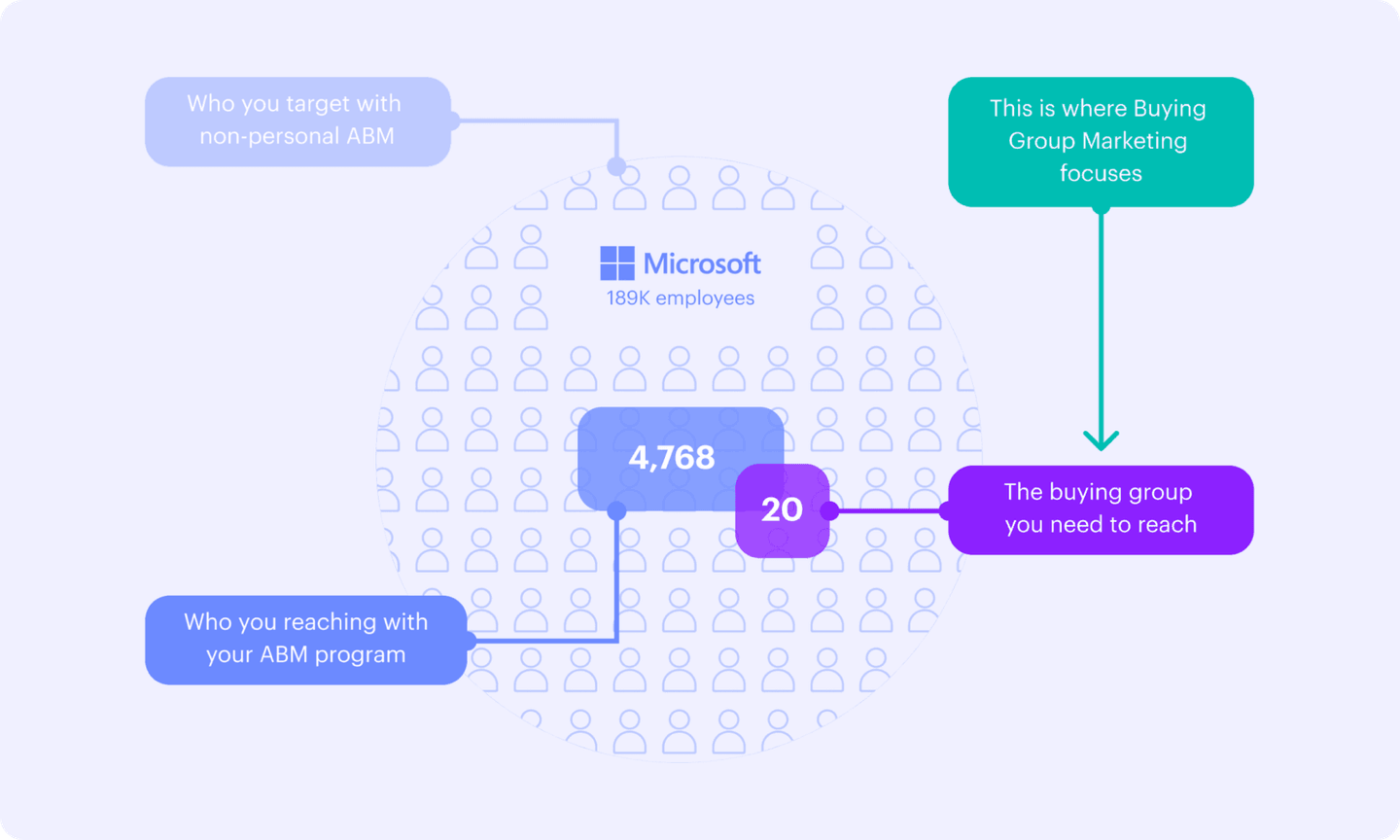
Figma’s only hope of identifying who’s engaging with their ABM program is if someone from Microsoft fills out a form on their website. However, the average form-fill conversion rate for B2B is only around 2%.
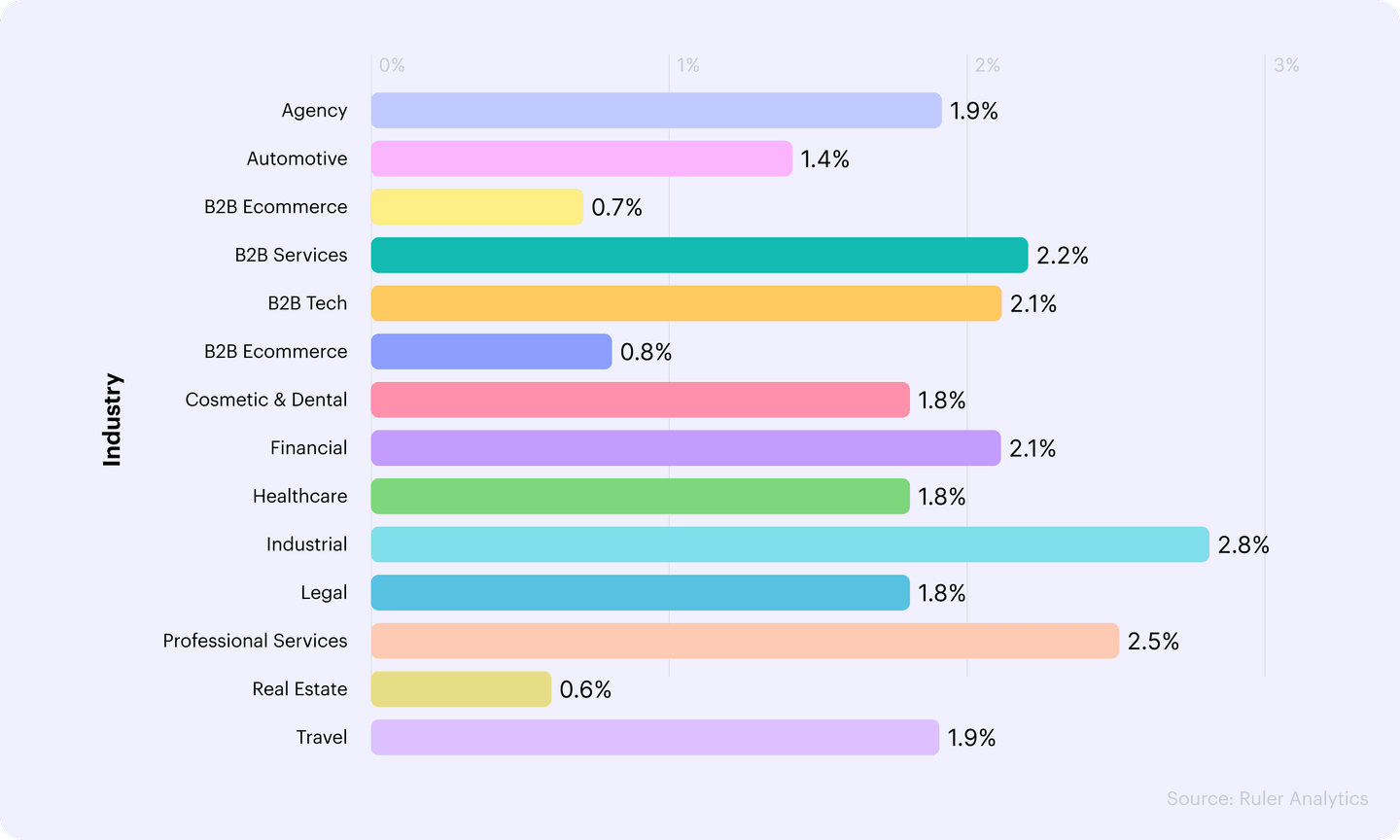
Influ2 helps solve these problems with contact-level ABM.
You can target named contacts at priority accounts and track who views and clicks your ads even if they don’t fill out a form.
Let’s dive deeper into how to use contact-level advertising and a unified GTM strategy to identify and influence buying committees.
How to identify who's in a buying committee
In a study from Foundry, 46% of marketers stated that identifying buying committees within high-intent accounts is one of their major ABM challenges.
Let’s look at two of the most straightforward ways to uncover buying committees.
Collaborate with Sales to align on personas
Marketing should work closely with Sales—and potentially CS—on this because they speak with prospects and customers every day.
You can build a relevant buying committee list just by sitting down with reps and asking them about who is typically involved in deals.
Of course, that’s not where account mapping has to stop.
You should also use real-world data to back up and expand on those assumptions.
A good starting point is to identify buying group personas by researching titles that are associated with past opportunities in your CRM.
You’ll likely find some obvious trends, such as a technical stakeholder like a CTO always being involved.
Something very important to keep in mind, though, is to focus on your ICP. Just because a deal was won doesn’t mean it’s the type of account you want more of.
Mapping personas for your buying committees based on accounts that churn after a few months puts your entire program on a shaky foundation.
Instead, build your buying group personas based on your happy customers since that’s what you want to replicate.
Once your personas are mapped out, you can use tools like LinkedIn Sales Navigator to help find the right people at your target accounts.
Use buying intent signals
At this point, you have a list of people you think are on the buying committee. But you can dig deeper to understand exactly who at your target account is expressing interest in your product.
Contact-level ads are immensely helpful here.
With Influ2, you can show ads to the people you believe are in a buying committee and track who engages with your ads.

When a targeted prospect clicks on your ad, it’s an intent signal that they have some level of interest in your product. Influ2 will send a notification to sales with who clicked which ad.
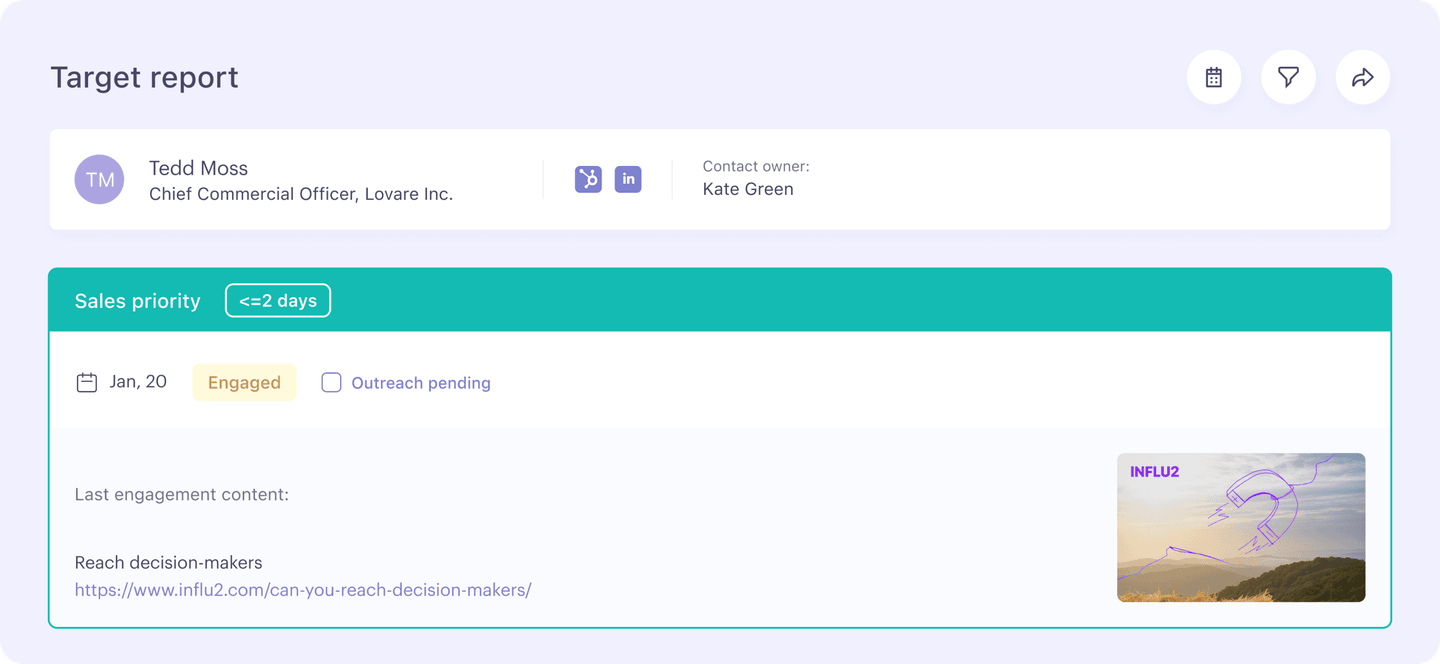
While ad engagement alone doesn’t mean a prospect is part of the buying committee, it gives the sales team context to reach out and start a conversation.
If they’re able to book a call, they can learn more about the company’s needs and find out who else is involved in the decision-making process.
This more focused approach is a better use of resources than having salespeople reach out to everyone in an account, most of whom aren’t interested in what you’re selling.
Instead, you can prioritize the people who have shown intent.
How to engage buying committees with multithreading and ads
The idea behind multithreading is to engage different members of the buying committee across multiple channels simultaneously, with messaging tailored to their needs and stage in the decision-making process.
While multithreading is often treated purely as a sales motion, marketing can help the process with contact-level ads.
Let’s look at how marketing can help sales multithread with relevant ads from three angles:
- Persona
- Buyer’s journey stage
- Intent
Persona
Your messaging should be tailored to the needs, challenges, and desires of each person in the buying group.
Let’s say our sales team is in talks with a target account but the CMO and CTO have some hesitations.
Even though they’re both in the buying committee, they have different concerns that are prolonging the deal.
The CMO thinks our software overlaps with their existing tech stack, and the CTO is worried about protecting customer data.
So, we might show the CMO ads that target the “our tools already do that” objection, while our CTO messaging is focused on data security concerns.
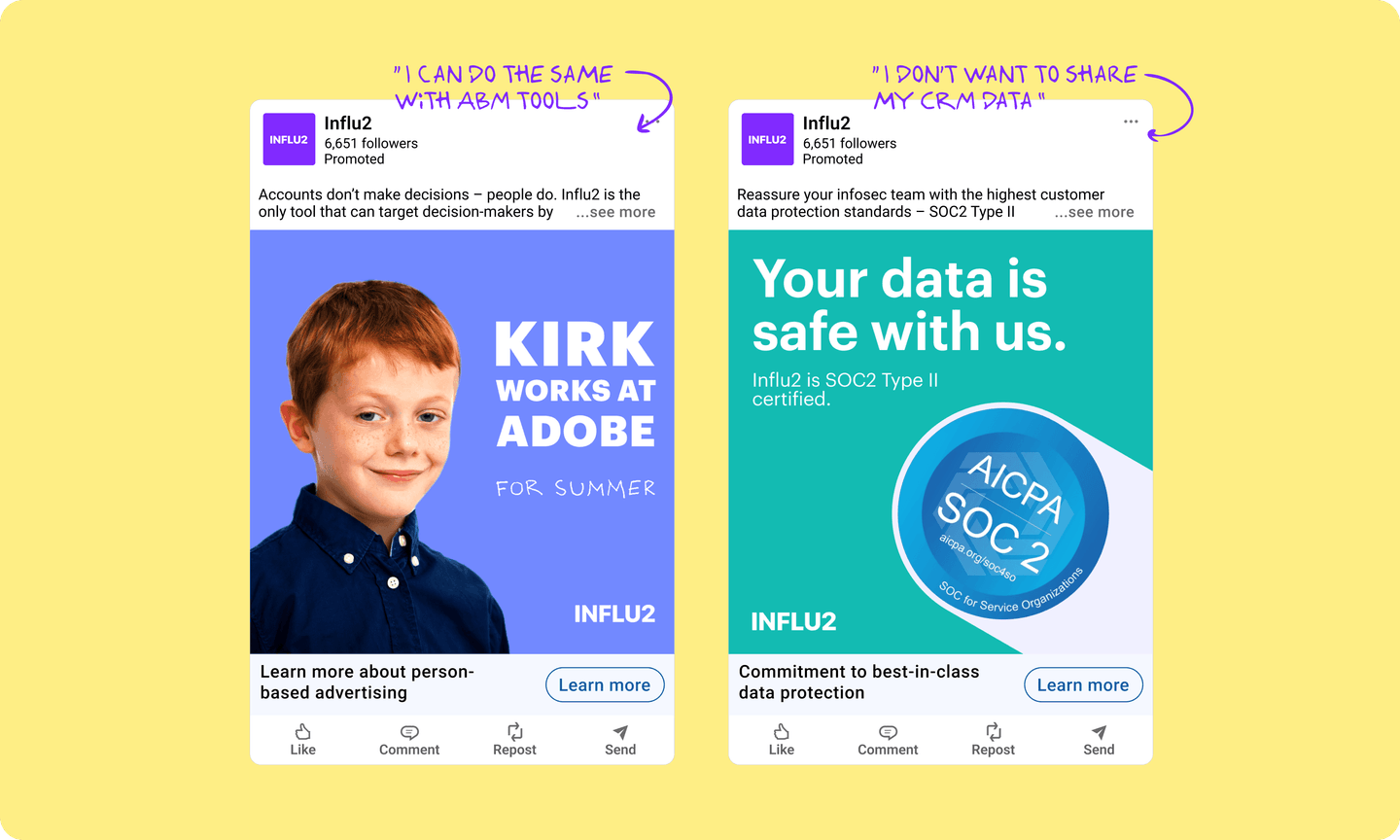
While sales continues to follow-up via email and LinkedIn messages, marketing is showing relevant ads across Facebook, Instagram, LinkedIn and display networks to address each buying committee member’s concerns.
Buyer’s journey stage
There’s a common misconception that everyone within a target account moves through the buying journey at the same pace.
The reality is your champion might have already had a demo of your product, while a VP at the company is only slightly familiar with your brand. Targeting them with the same messaging doesn’t make sense.
With Influ2's custom buyer journeys, you can show prospects at the beginning of the sales cycle thought leadership content and brand awareness messaging, while people further along can see messaging that speaks to the value of your product, backed up by social proof.
For example, we might use an ad flow that looks something like this:
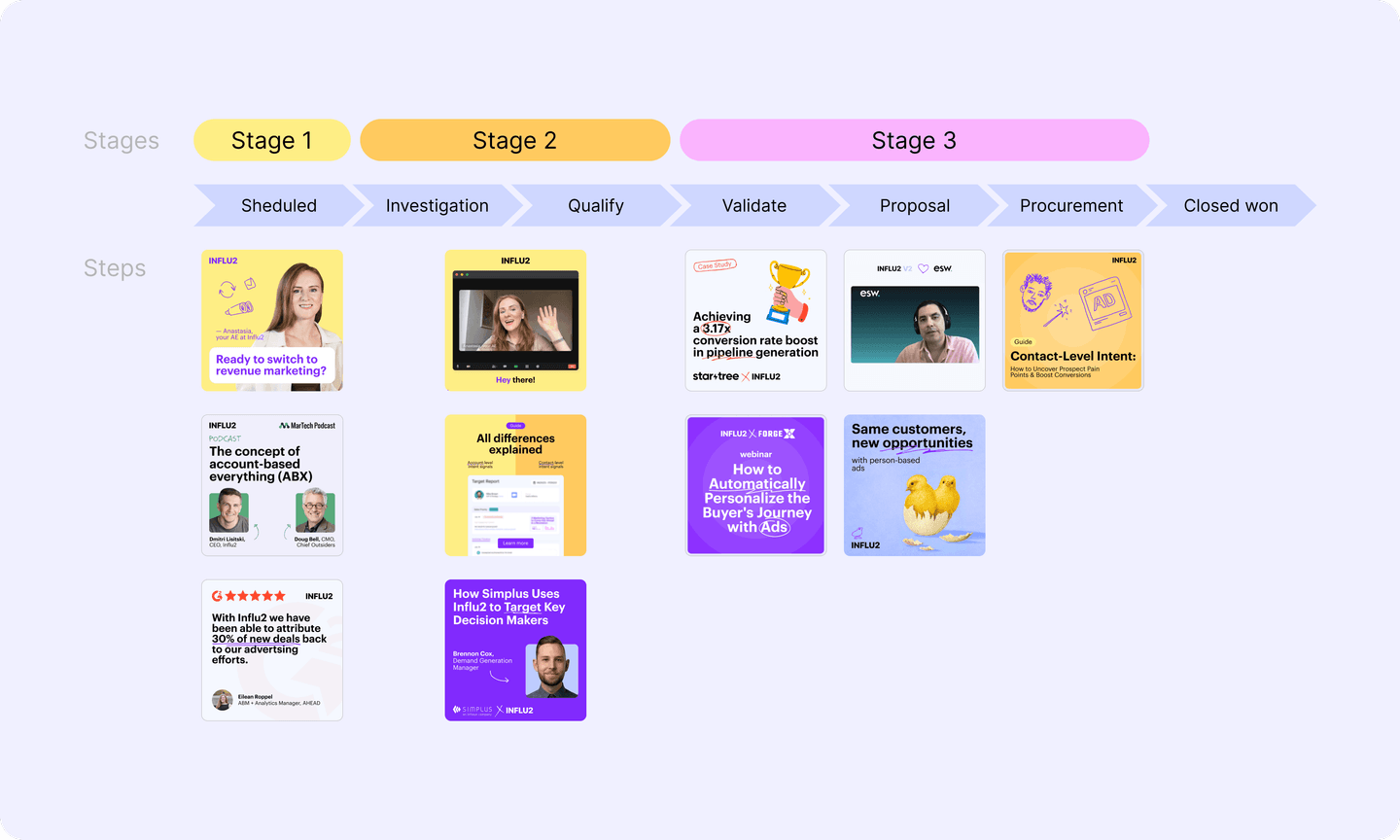
At Stage 1, our messaging is based on building trust and awareness.
At Stage 2, we know the prospect is aware of our company so we start including more of the product into our ads. We might show them videos that showcase product capabilities to help prospects see how our solution fits their needs and solves their challenges.
As the buyer becomes more invested and moves into Stage 3, we switch to in-depth resources like case studies and guides, helping them make more informed decisions and using social proof and real-world use cases.
Intent
Here’s a common scenario.
Your sales team is in talks with their champion at a target account, but they need to get buy-in from their Director (another member of the buying group) before moving forward.
However, the Director has a lot on their plate and a sales call is at the bottom of their priority list, so the deal gets stalled.
This is a great opportunity for marketing to get involved and provide air coverage by targeting the Director with ads that reinforce the value of your product and nudge them into taking action.
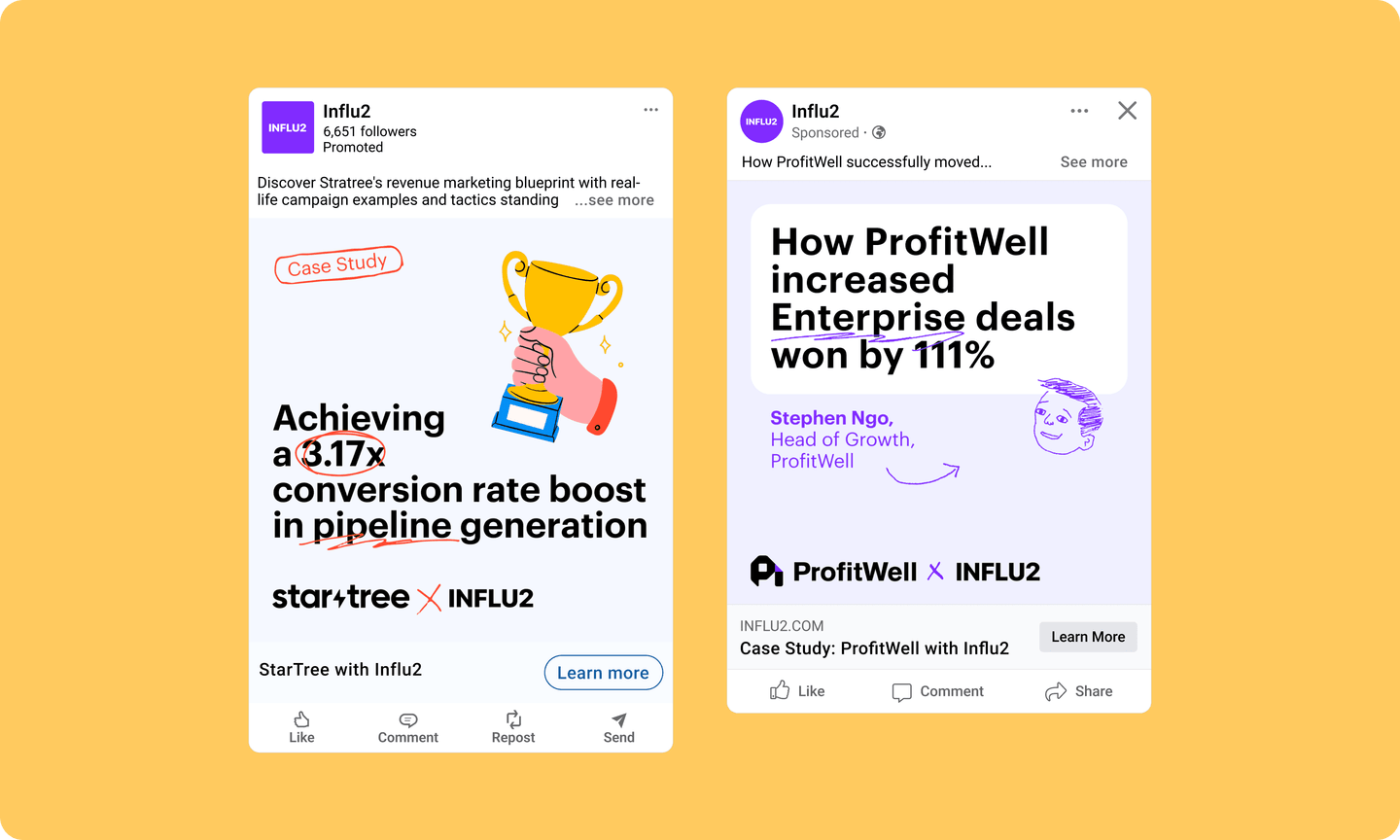
Influ2 will track when the Director sees and engages with the ads. Once they click an ad, that’s the perfect time for Sales to follow-up on the intent signal with a message that references the champion at the company and the context of the ad they clicked.
Note: Influ2 provides multiple contact-level intent signals, including from search, social, and third-party content consumption. Learn more here!
How to keep Marketing and Sales on the same page throughout the deal
The foundation of Sales and Marketing alignment is an agreement on which people are targeted.
The problem we've seen is that, as deals progress, it’s challenging for each team to track who the other is targeting or engaging with.
Let’s look at an example of how Marketing and Sales can work together to uncover and target a buying committee as a deal moves forward.
Say your company is a sales engagement platform and you’re targeting PandaDoc.
Assume Sales and Marketing worked together to map out the account. Before Sales starts reaching out, Marketing is already running awareness-focused ads using Influ2 to target specific contacts in the account.
Marketing also sets engagement thresholds in Influ2 to automatically notify Sales when a target prospect engages with an ad.
Initially, the VP of Global Sales at PandaDoc was identified as a key stakeholder. However, one of the company’s Sales Managers clicked your ad.
That data gets passed to Sales, including who engaged and what they engaged with. Sales hopes to leverage the Sales Manager to influence the VP of Global Sales, so they reach out and book a meeting.
Through the call, Sales learns that while the VP is involved in the buying process, the Director of Revenue Expansion is also a key player.
This Director is added as a contact in the account, which is synced to Marketing’s target list in Influ2 so that they can also target them with ads.
The process makes it easier for both teams to know what the other is doing and gives insights into exactly who’s being targeted at all times.
Final thoughts
Every GTM leader knows that you can’t win just by buying more volume anymore.
Figuring out who makes up the buying committee is one thing, but loading them up with email outreach, cold calls, and generic ad creative isn’t going to help influence a decision.
Personalization and relevant messaging are key, no matter what channel you’re operating in.
For more tangible examples of ad personalization in practice, check out our playbook: 15 ABM Campaign Examples to Personalize Every Stage of the Buyer’s Journey.
And if you’re interested in learning how Influ2 can help you engage buying committees with contact-level ABM, let’s talk.



